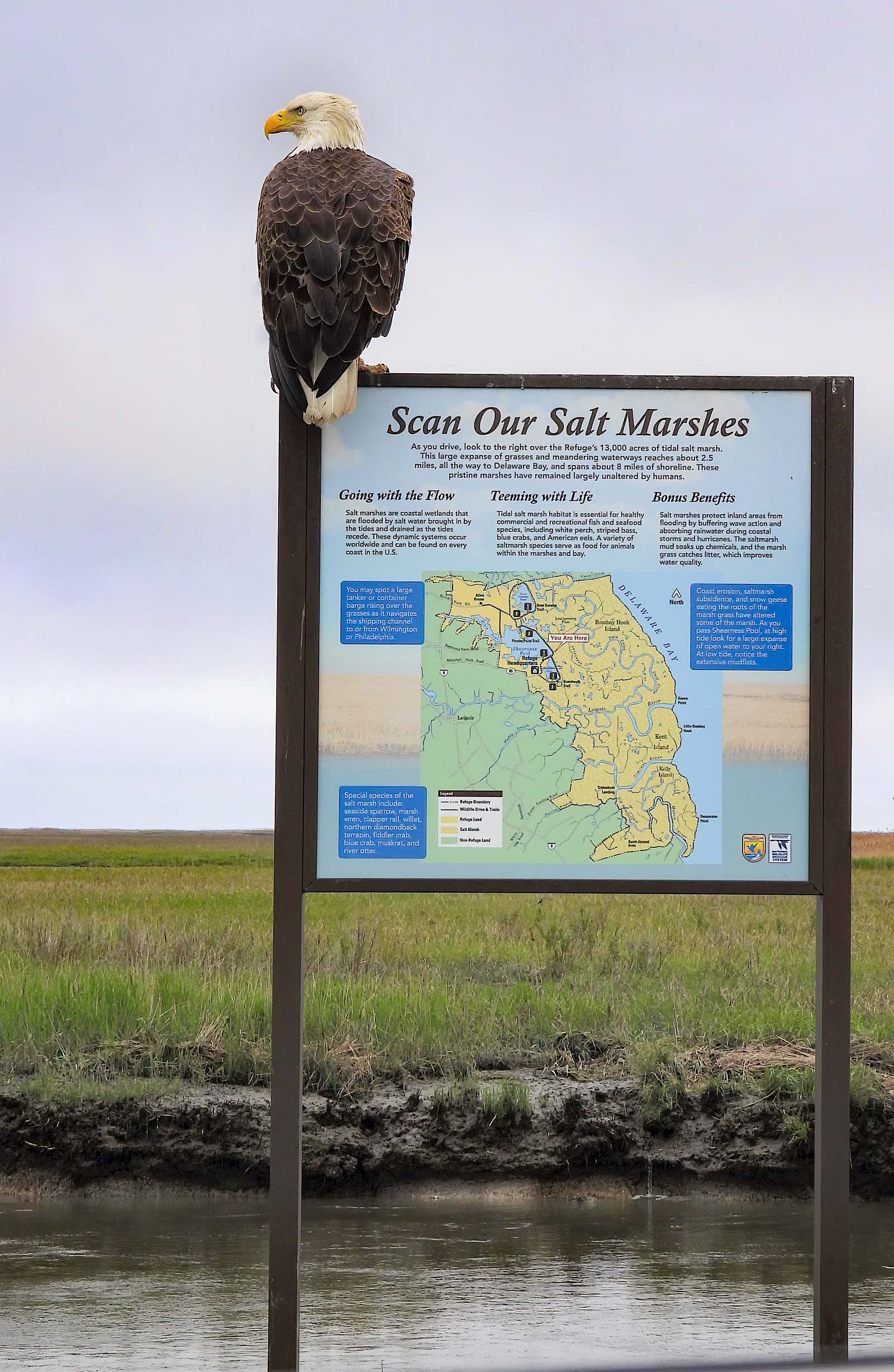Things to do
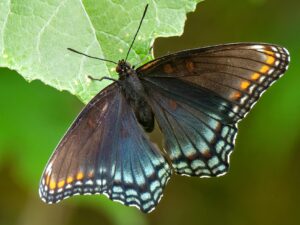
Most visitors to the refuge drive the 12 mile widlife drive, viewing the impoundments and other habitats from the road and exploring the several short trails and observation towers. The tour route can also be explored on foot or by bicycle.
Much of the rich diversity of wildlife in the refuge can be viewed from the roadway. Common acitivities include wildlife viewing, birding and nature photography. At certain times of year the numbers of shorebirds, ducks, egrets or Snow Geese can be overwhelming. Foxes, Beavers and Muskrats can be seen, especially early in the morning.
The earlier you come, the more wildlife will be visible. The best viewing conditions are in the morning when the tide is high. During high tide, the birds roost in the impoundments and in the morning the sun is at your back for viewing them. Drive slowly to see the most wildlife and multiple trips around the wildlife drive are often productive as the wildlife visible changes constantly.
In the summer, perpare for mosquitos and especially biting flies, which can be fierce in July and August. It is best to come on windy days in the late summer because wind suppresses fly activity. Nevertheless, much can be seen from iniside the car even when flies are bad.
Be sure to review the Visitor Information page for hours and fees.

Virtual Tour
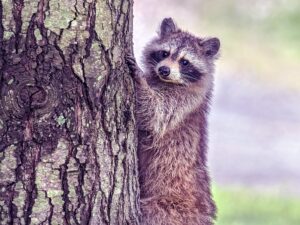
Welcome to our virtual tour of Bombay Hook National Wildlife Refuge. You are invited to take the tour and learn about points of interest on the refuge. We hope this tour will introduce you to Bombay Hook and prepare you for your next visit.
Our virtual tour will highlight eleven points of interest at the refuge. Each point of interest is marked in red on the public tour route map shown below.
The map shows the portion of the refuge covered by the public tour route, a twelve mile round trip that passes through many of the refuge habitats. The public tour route is the main artery through the refuge. Visitors may drive, walk, or bicycle it; or they may stop their vehicle along the side of the road and observe and photograph. Also marked on the map are the locations of the freshwater impoundments (shown in blue), the five refuge walking trails, and the three observation towers.
Tour Map. See below for information about each stop.
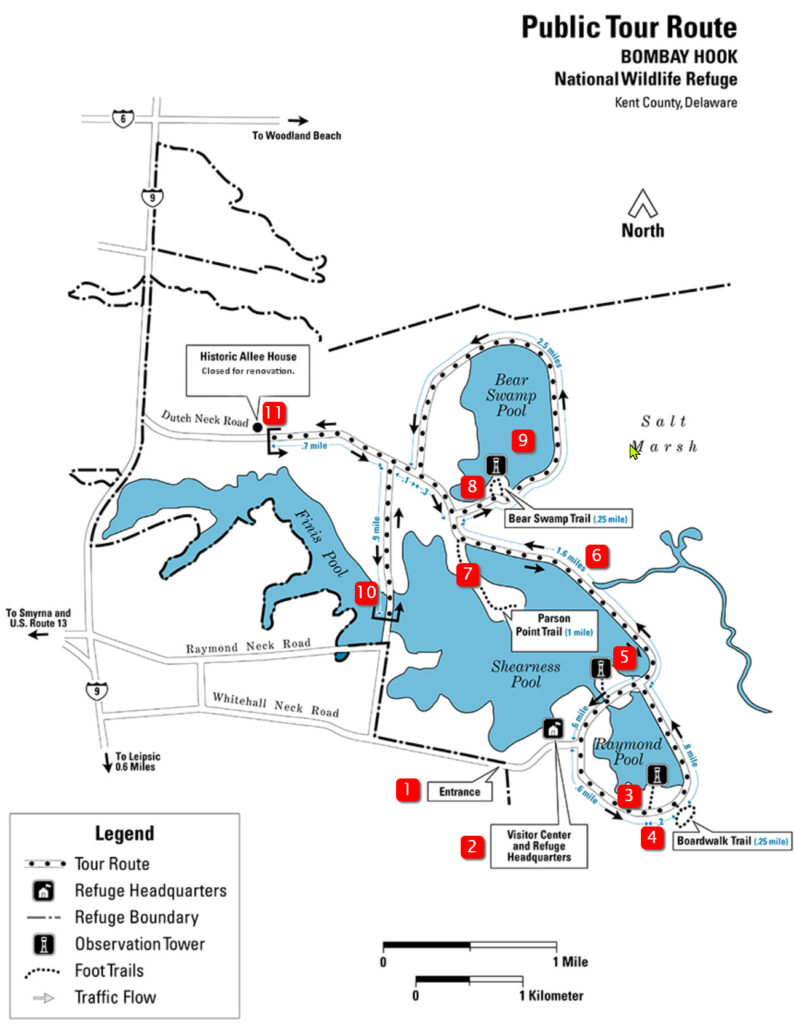
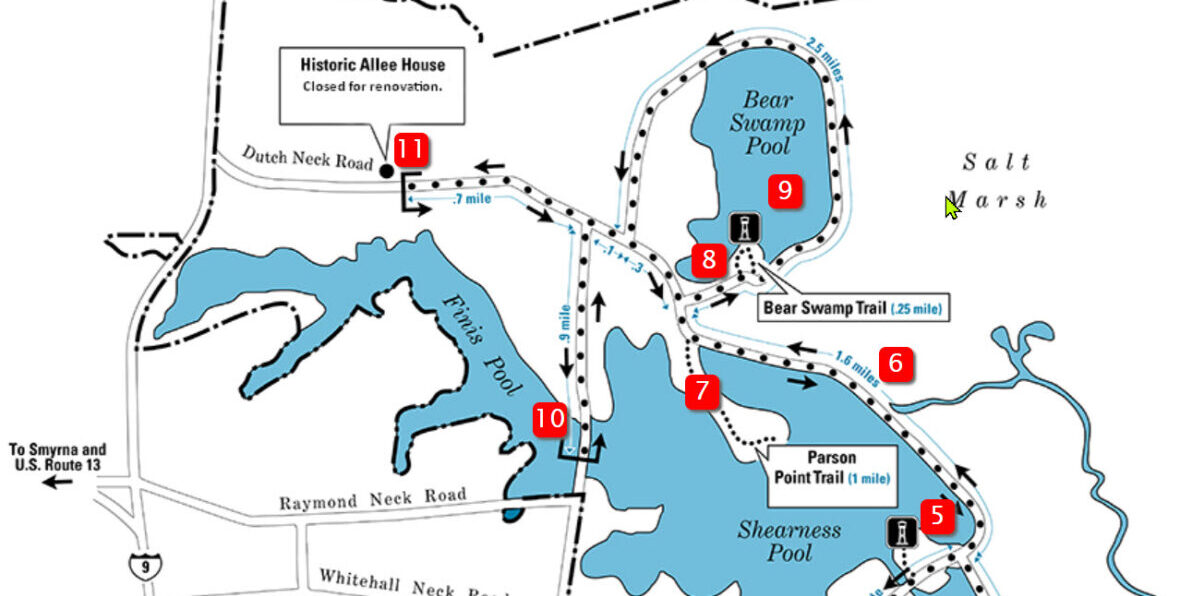
Tour Stops. Click to expand.
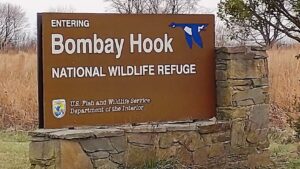 Welcome to Bombay Hook National Wildlife Refuge. The refuge covers about 16,000 acres in central Delaware along the western shore of the Delaware Bay.
Welcome to Bombay Hook National Wildlife Refuge. The refuge covers about 16,000 acres in central Delaware along the western shore of the Delaware Bay.
Bombay Hook was created in 1937 and is managed primarily for migrating and wintering ducks and geese, shorebirds and other migratory birds. The great diversity of plant and animal life found here is the result of its many habitats—freshwater, brackish, salt marsh, bay, grassland, cropland and woodland. Bombay Hook is known internationally as a birding hotspot, and is recognized by the American Bird Conservancy as an Important Bird Area.
Bombay Hook is a great place to view and photograph wildlife, contemplate the beauty of nature and enjoy the great outdoors. The refuge is open from sunrise to sunset every day of the year. An entrance fee is charged.
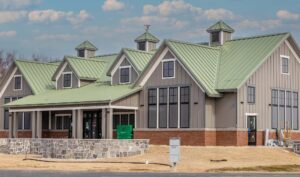 The headquarters building houses the Visitor Center, the Refuge Store, and the offices of the U. S. Fish and Wildlife Service staff.
The headquarters building houses the Visitor Center, the Refuge Store, and the offices of the U. S. Fish and Wildlife Service staff.
The Visitor Center is open from 8:00am to 4:00pm Monday through Friday throughout the year and from 9:00am to 5:00pm on weekends in March, April, May, September, October, and November. Exhibits depicting the plant and animal life of Bombay Hook are on display in the lobby and auditorium. Refuge maps and literature are available, and a staff member or volunteer is on hand to answer your questions. The Refuge Store, which is run by the Friends of Bombay Hook and located in the Visitor Center, sells books, souvenirs and collectibles.
Restroom facilities accessible 24 hours a day are located through the automatic door to the left of the entrance.
Entrance fees may be paid at the kiosk adjacent to the front door.
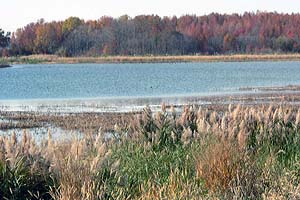 Raymond Pool is one of the four refuge freshwater impoundments, which are shown on the tour map in blue. It was the first impoundment to be created. The dike and the water control structures were built by the Civilian Conservation Corps, a work relief agency created by the federal government. Work began in 1939 and was completed in 1940.
Raymond Pool is one of the four refuge freshwater impoundments, which are shown on the tour map in blue. It was the first impoundment to be created. The dike and the water control structures were built by the Civilian Conservation Corps, a work relief agency created by the federal government. Work began in 1939 and was completed in 1940.
A short trail from the parking lot leads to the southern shore of the pool, where a 30 foot high observation tower provides a commanding view of the pool and the surrounding woods.
Shorebirds are abundant here in the late spring as they migrate northward to nest and then again in early fall as they migrate south. Ducks and geese are numerous in the fall and winter months. In the wooded areas, migratory songbirds are seen and heard in spring and fall.
The impoundment water levels are drawn down in the spring to expose the mudflats, which expose prime feeding areas for migrating shorebirds; water levels are kept higher in the fall and winter to promote the growth of emergent and underwater plants for waterfowl.
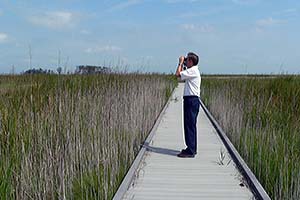 The Boardwalk Trail is about 0.5 mile long and was built in 1973 by members of the Youth Conservation Corps. It was renovated in 2010 and is now handicapped-accessible. This trail offers the visitor the only opportunity to study the tidal salt marshes that cover eighty percent of the refuge and that are among its most important assets.
The Boardwalk Trail is about 0.5 mile long and was built in 1973 by members of the Youth Conservation Corps. It was renovated in 2010 and is now handicapped-accessible. This trail offers the visitor the only opportunity to study the tidal salt marshes that cover eighty percent of the refuge and that are among its most important assets.
The trail passes through many of the refuge habitats; it begins in a small upland woodlot bordered by brackish ponds, and then emerges on to a boardwalk over the high salt marsh before reentering the woods and returning to its point of origin.
In the warmer months, the brackish ponds are teeming with sheepshead minnows, mummichogs, killifish and blue crabs. The woodland areas, made up of persimmon, sweetgum and cherry trees, are populated with wood warblers and other songbird species in the spring and fall. In the saltmarsh, white-tailed deer, raccoon and muskrat are often seen; sparrows and marsh wrens are the predominant bird species; and fiddler crabs are abundant in the marsh mud. Ducks, geese and shorebirds are found on the salt ponds.
For more information, please see the Boardwalk Trail brochure, published by U. S. Fish and Wildlife Service.
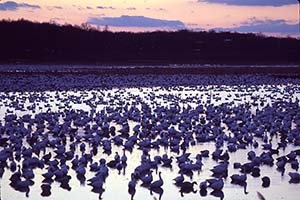 Shearness Pool is the largest of the four freshwater pools. It is the most likely area on the refuge to see bald eagles, which often nest in the woods behind the pool.
Shearness Pool is the largest of the four freshwater pools. It is the most likely area on the refuge to see bald eagles, which often nest in the woods behind the pool.
During late spring and summer, thousands of migrating shorebirds are seen here; from late fall through the winter the pool is occupied by thousands of ducks and geese. The winter time population of snow geese at Bombay Hook exceeds 100,000 in some years. The birds leave the refuge in the morning hours in search of food, foraging in farm fields miles away, and return at dusk to roost. The sight and sound of thousands of snow geese on Shearness Pool at dusk are spectacular.
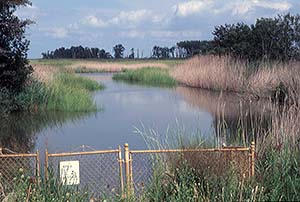 Approximately 80% of the 16,000 acres of Bombay Hook is tidal salt marsh. The refuge has one of the largest expanses of nearly unaltered tidal salt marsh in the mid-Atlantic region. It is considered to be one of Delaware's most valuable habitats.
Approximately 80% of the 16,000 acres of Bombay Hook is tidal salt marsh. The refuge has one of the largest expanses of nearly unaltered tidal salt marsh in the mid-Atlantic region. It is considered to be one of Delaware's most valuable habitats.
Tidal saltmarsh supplies organic materials for the food chain, circulates nutrients, provides nesting habitat for waterfowl and serves as a nursery area for fish.
In the late spring and early fall, migratory shorebirds can be seen feeding on the mudflats exposed at low tide. In the fall and winter, ducks and geese predominate. A sudden burst of activity in a feeding or roosting flock of shorebirds or waterfowl may signal the presence of a peregrine falcon or a bald eagle. Northern harriers are often seen hunting on the salt marsh.
The mud and reed mounds seen across the tidal salt marsh are muskrat houses.
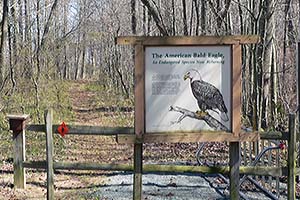 The Parson Point Trail is a one mile round trip through an isolated woodland forest. The forest is situated on a spit of land surrounded on three sides by Shearness Pool.
The Parson Point Trail is a one mile round trip through an isolated woodland forest. The forest is situated on a spit of land surrounded on three sides by Shearness Pool.
This habitat is ideal for many plants and animals. Bald eagles, which require isolated forested areas with tall, mature trees for nest-building, are often seen here and nested here for years. In the past, the trail was closed during nesting season, from November to June, as indicated on the map. It is now open year round.
Other bird species often seen on the trail include red-bellied woodpecker, flicker and, during spring and fall migration, wood warblers. In spring, fox kits are often seen near their dens, which are found near the trail head.
During World War II Bombay Hook was home to test range operated by the 4146th Base Unit located at the Dover Army Air Base (Dover Air Force Base). The range was used to support a rocket research program and included a precision firing section and a night explosive section. The remains of a building that was a part of that program are visible from the Parson Point Trail.
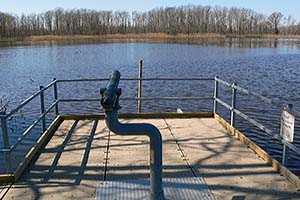 The Bear Swamp Trail, a one quarter mile loop, is located at the south end of Bear Swamp Pool. From the parking area, the trail runs north following the shoreline of the pool to a floating observation deck equipped with a spotting scope, and then to a 30 foot high observation tower, which provides a superb view of the southern reaches of Bear Swamp Pool. The trail makes its way back through a hardwood forest.
The Bear Swamp Trail, a one quarter mile loop, is located at the south end of Bear Swamp Pool. From the parking area, the trail runs north following the shoreline of the pool to a floating observation deck equipped with a spotting scope, and then to a 30 foot high observation tower, which provides a superb view of the southern reaches of Bear Swamp Pool. The trail makes its way back through a hardwood forest.
Bear Swamp Pool and Bear Swamp Trail were built in 1961. The area was known historically as Bear Swamp, although bears no longer inhabit Delaware; the last recorded sighting was in 1905.
The trail was recently renovated and is now handicapped accessible.
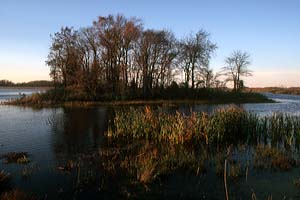 Like the other impoundments, Bear Swamp Pool is used throughout the year by many bird species.
Like the other impoundments, Bear Swamp Pool is used throughout the year by many bird species.
In the summer months, the islands are used as loafing or resting areas by wading birds, such as great blue heron, great egret, snowy egret and black-crowned night heron; black-necked stilt and black-crowned night heron nest on these islands. Flocks of great egrets and black-crowned night herons can be seen roosting in the trees on the northern-most island.
In the fall and winter months, the pool is inhabited by Canada geese and many species of duck.
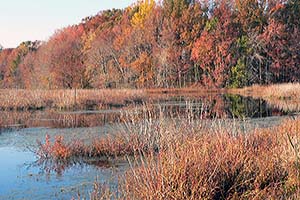 Fed by Finis Branch, the primary fresh water source for all of the refuge impoundments, Finis Pool contains the freshest water found on the refuge.
Fed by Finis Branch, the primary fresh water source for all of the refuge impoundments, Finis Pool contains the freshest water found on the refuge.
Beaver, muskrat, turtles and occasionally otter are seen here. Barred owls inhabit the trees across the road. In summer months, snowy and great egrets, in breeding plumage, are often seen in the area of the water control structure.
In winter, many species of ducks, including common and hooded mergansers, mallards, gadwalls and green-winged teal are seen in the pool.
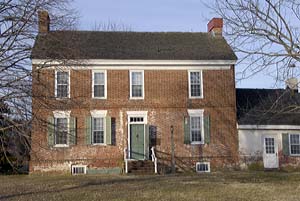 The Allee House was built in the mid 1750's by Abraham Allee, a prominent figure in Kent County political life. It is considered to be one of the finest examples of an early brick farmhouse in Delaware.
The Allee House was built in the mid 1750's by Abraham Allee, a prominent figure in Kent County political life. It is considered to be one of the finest examples of an early brick farmhouse in Delaware.
Some minor restoration work was done on the house and outbuildings in 1966. In 1971, it was placed on the National Register of Historic Places.
The house has fallen into disrepair due to lack of funding and is now in need of major repair work. It is closed to the general public until repairs have been completed.
The Friends of Bombay Hook hope to raise the funds necessary to stabilize the historic house by preventing further settling of the foundation and eventually to restore the house to its original condition.
Restrooms: Handicapped-accessible facilities located at the Visitor Center are open 24 hours a day. Additionaly, toilets are located at Bear Swamp Trail and Pasture Point Pond.
Food and Drink: Food and drink are not available at the refuge. The nearest store is about six miles away.
